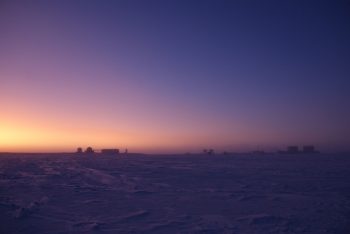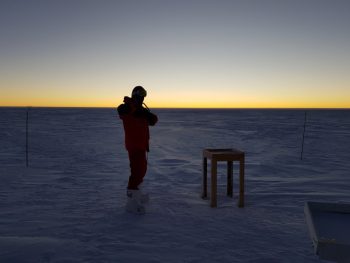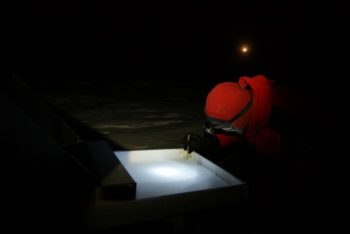Dr. Carmen Possnig is the ESA-sponsored medical doctor spending 12 months at Concordia research station in Antarctica. She facilitates a number of experiments on the effects of isolation, light deprivation, and extreme temperatures on the human body and mind. In the following post, Carmen discusses extreme weather in Antarctica.
Outside temperature: –64°C
“It is not really cold again,” mumbles Cyprien as he packs his radio, looking at the weather display opposite the front door. I nod in agreement. Since we want to reach at least –80°C, we are not satisfied with the spring-like –64° in Antarctica.
Again and again it is a surprise how dark it is when I open the heavy door of the exit. As soon as my companion closes it behind us, we are almost completely surrounded by darkness. The feeling is pleasant and familiar, but it takes me a while to get used to the biting cold. A few square centimetres around my eyes are the only areas I expose to the cold.
The crunching of my boots on the dry snow makes me feel happy. For a week I had little opportunity to leave the station for a longer period of time, so this weekend trip is all the more beautiful. We walk around the station towards Atmos, the external laboratory for glaciologists and meteorologists. The waning moon is bright enough to cast strange shadows on the snow and brighten our path.
As soon as we turn towards Atmos, the ice-cold wind almost takes my breath away. I put on my mask to protect the rest of my face. My nose still hurts from the last frostbite. The problem with the mask is that you are practically blind after a few minutes. It freezes inside within a very short time. This time I have another problem: somewhere there is a small gap and the wind has found it.
Next to me my companion staggers over some snow drifts and finally says: “The wind is a bit fresh today.” I can practically see his broad grin through his two layers of balaclava and reply: “Yes, it tickles my eyeballs.” After adjusting the mask, things go much better.
After about 20 minutes, Cyprien suddenly stretches out his arm to prevent me from running against his snow tables in an inelegant manner. Four of them stand a few hundred meters away from Atmos and are used for various investigations of snowflakes, snow crystals, their accumulations and drifts.
Here the headlamps are unpacked. If you put them on earlier, they freeze, and the light is off before you reach the tables. While the glaciologist provides his measuring equipment, I try to see something on my clipboard. The first thing to do is to assess the weather.
Visibility? Up to my little finger. On the other hand, with my head on my neck, you can see the Magellanic Clouds.

If you close your eyes too long, you can no longer open them thanks to frozen eyelashes. Credits: PNRA/IPEV–C. Verseux
I turn to Cyprien, who sits a few meters away in the snow and stares concentrated through a magnifying glass at ice crystals. While I wait for him and observe Mars in the distance, the air glitters all around: tiny snowflakes fly around me, my breath turns into a dense white cloud and follows them. “32cm”, I hear behind, and I begin to write down the snow accumulations.
We continue to Atmos to store snow samples and to change various filters. Atmos is one of our outdoor laboratories, in this case a collection of containers. In most shelters it is reasonably warm, at least above 0°C. Atmos is in some rooms even over 10°C, so it is wonderfully suitable to thaw frozen fingers again.
In Atmos, air is sucked in through the roof with various pumps and passed through many different filters. These filters have to be changed at different intervals, some daily, some weekly, some monthly. Various particles in the atmosphere are examined with these filters.
On our way back we are again surrounded by complete darkness. The station is too far away to see the few illuminated windows. You never know what to expect from the next step – Cyprien sinks down to my knee in the snow, while I stumble over a hill that is as hard as concrete.
The rustle of the wind, our heavy breathing, occasional “oops” when we stumble. We stop again and again to catch our breath and admire the spectacle above us: the Milky Way spans an enormous arc across the sky, a myriad of stars I have never seen before. Shooting stars fly before our eyes, and Mars shines seductively close. Under all the magic of polar night, Concordia actually seems like a space station on a strange, strange planet, and we feel a bit like astronauts as we return to the Station’s warmth and peel ourselves out of our suits.
We are back home.
To read Carmen’s adventures at Concordia in German, see her personal blog.







Discussion: no comments